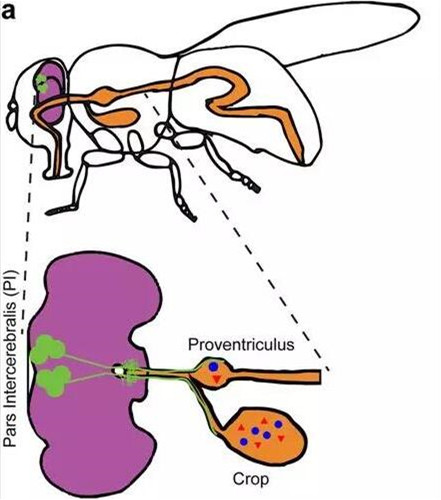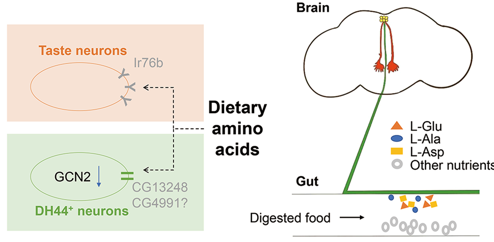Drosophila's dietary preference sheds light on “gut feeling”
As a Chinese advertisement puts it, you will have more of this food if it is delectable. YANG Zhe, a PhD student at the Life Sciences Institute, Zhejiang University, observed this phenomenon in the kingdom of fruit fries. Thus, he followed this crucial clue in his research and identified a key sensor to detect amino acids, only to find that fruit fries could also taste gourmet food via their “taste buds” in their gastrointestinal tract. It seems like that we really should trust our “gut feeling”.
Two weeks after these findings were published in an article entitled “A post-ingestive amino acid sensor promotes food consumption in Drosophila” in Cell Research, Prof. Anupama Aahanukar from the University of California, Riverside, reviewed this article in the Research Highlight column in Cell Research. “The findings of Yang et al. are very interesting and act as a catalyst for human thinking in a series of issues related to the sense of taste, thus deepening the human understanding of gustation,” observed Anupama Aahanukar.
Can fruit fries taste amino acids? The research team led by WANG Liming at the Life Sciences Institute started their research from this intriguing question. They fed food with different ingredients to fruit fries. In experiments, fruit fries could choose to eat or not to eat. Researchers found out that food with amino acids could increase the food consumption of fruit fries by 50%-100%.
“There may exist an internal mechanism for sensing amino acids in fruit fries,” said WANG Liming. In vivo and ex vivo calcium imagings showed that six brain neurons expressing diuretic hormone 44 (DH44) could be rapidly and directly activated by these amino acids, suggesting that these neurons are an amino acid sensor. “The axonal terminals of DH44+ neurons have been found to be located in the gastrointestinal (GI) tract. This is really enigmatic,” WANG added.

Genetic inactivation of DH44+ neurons abolished the increase in food consumption induced by dietary amino acids, whereas genetic activation of these neurons was sufficient to promote feeding, implying that DH44+ neurons could mediate the effect of dietary amino acids to promote food consumption. Single-cell transcriptome analysis and immunostaining revealed that a putative amino acid transporter, CG13248, was enriched in DH44+ neurons. Knocking down the CG13248 expression in DH44+ neurons blocked the increase in food consumption and eliminated calcium responses induced by dietary amino acids. Therefore, these data identified DH44+ neuron as a key sensor to detect amino acids and to enhance food intake via a putative transporter CG13248. These results shed critical light on the regulation of protein homeostasis at organismal levels by the nervous system.

A working model of dietary amino acid sensing in fruit flies. (Left)
Besides a well-documented peripheral sensing mechanism involving Ir76b, the present study proposes a speculative model of a central sensing mechanism, in which DH44+ neurons detect L-Glu, L-Ala and L-Asp via a putative amino acid transporter CG13248 and possibly also CG4991. (Right)
“The findings of Yang et al. pose a number of interesting questions and present a compelling brain-gut microcircuit that senses three dietary amino acids and promotes intake through DH44 signaling, along with a starting point for addressing new questions,” Anupama Aahanukar commented.